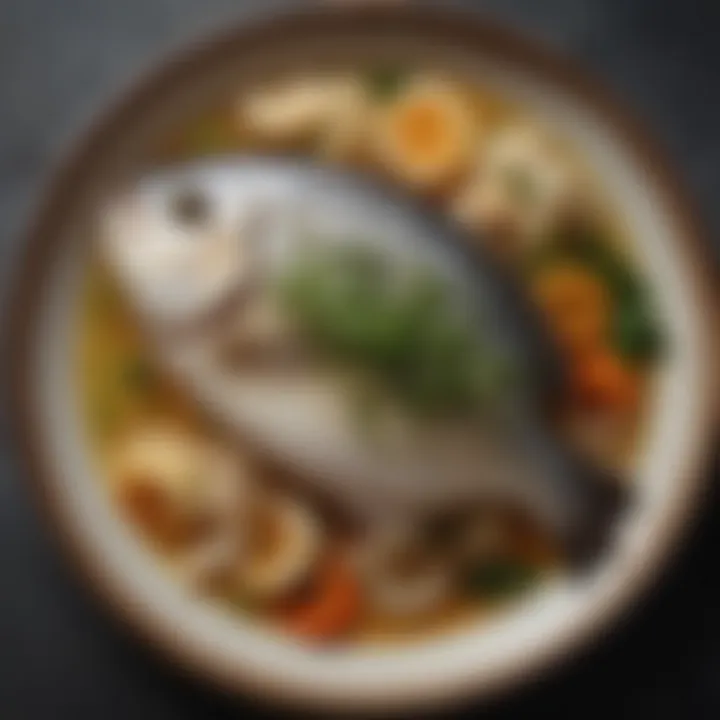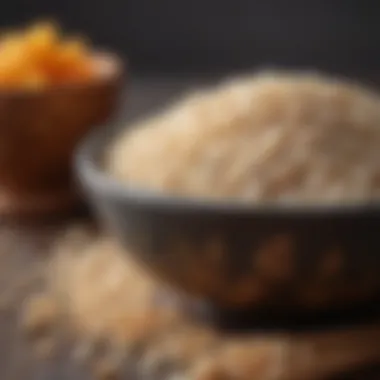Chinese Cuisine for Diabetics: A Flavorful Guide


Intro
Delving into the world of Chinese cuisine offers a grand adventure for the taste buds. But for diabetics, navigating this flavorful landscape can feel like treading a tightrope. The challenge lies not only in choosing the right dishes but also in understanding the intricate dance of ingredients that make up the meals. Whether it's the savory stir-fries or comforting soups, it’s essential to make informed decisions that honor the palate while paying heed to blood sugar levels.
Chinese food is bursting with various flavors and textures, presenting an excellent opportunity for those with dietary restrictions to indulge their cravings without compromising their health. This guide aims to demystify the essentials of indulging in Chinese dishes when managing diabetes. By examining ingredients, exploring options, and making thoughtful substitutions, we aim to enhance both the culinary experience and blood sugar management.
The heart of this guide features practical insights into meal preparations and dish selections that can help balance taste and health. Let’s embark on this journey together, ensuring you have all the tools necessary to savor the rich legacy of Chinese cuisine, all while keeping mindful of your dietary needs.
Recipe Overview
Stir-Fried Broccoli with Tofu
This stir-fried dish is a harmonious blend of crunchy broccoli and silky tofu, seasoned with low-sodium soy sauce, garlic, and ginger. It offers a satisfying texture while being low in carbohydrates, making it ideal for managing blood sugar levels. The light, savory notes combined with the nutritional benefits of both broccoli and tofu provide a delicious and smart dining choice.
Ingredients List
Main Ingredients
- Fresh broccoli
- Firm tofu
- Low-sodium soy sauce
- Garlic
- Fresh ginger
- Olive oil or sesame oil
Optional Ingredients
- Red pepper flakes for heat
- Chopped green onions for garnish
- A splash of rice vinegar for tanginess
With these ingredients, one can whip up not only a delightful dish but also a feast for the eyes, all while taking steps towards better health.
"Food should be fun and enjoyable, regardless of dietary restrictions. Finding those balancing acts makes all the difference."
Understanding Diabetes Management
For individuals living with diabetes, managing this condition effectively is a multifaceted challenge. It encompasses various aspects, but the cornerstone often lies within dietary choices. Understanding diabetes management becomes essential in process of choosing foods, especially when considering flavorful and culturally rich cuisines like Chinese. Managing diabetes well can lead to not only a balanced blood sugar level but also to overall well-being and enriched quality of life.
Managing diabetes is not solely about restrictive eating; it’s about making informed decisions that support health while enjoying the culinary world. By grasping the nuances of how different foods affect blood sugar, people can strike a balance between indulgence and health.
The Importance of Diet in Diabetes Control
A well-structured diet is indispensable for maintaining blood sugar levels within the target range. Foods with high nutritional value can positively influence insulin sensitivity, reduce complications, and support weight management. A diverse diet that includes whole foods, fiber-rich vegetables, and lean proteins can help in stabilizing blood sugar.
For diabetics, the goal isn't to avoid all carbohydrates but rather to focus on those that impart vitamins and minerals while having a lower glycemic index. This means that foods release glucose gradually into the bloodstream, preventing sudden spikes. Think brown rice or whole grain noodles instead of white rice.
How Carbohydrates Affect Blood Sugar Levels
Carbohydrates have a significant effect on blood sugar levels. They can be broadly categorized into simple and complex carbohydrates. Simple carbohydrates—found in sugary snacks and drinks—can cause sharp spikes in blood sugar. In contrast, complex carbohydrates—like those found in legumes and whole grains—are digested more slowly and keep blood sugar levels steadier.
For someone managing diabetes, it's key to be aware not just of the type of carbohydrates consumed, but also their quantity. Using portion control can also play a crucial role here. Keeping tabs on how much is eaten at once can help mitigate any erratic blood sugar patterns. Additionally, incorporating foods that are high in fiber can help in managing overall carbohydrate impact by slowing the digestion process.
Nutritional Guidelines for Diabetics
Navigating food choices can be overwhelming, yet clear guidelines can simplify the process. Here’s a coherent set of dietary recommendations:
- Prioritize whole foods: Opt for unprocessed foods like fruits, veggies, and whole grains.
- Watch portion sizes: Smaller portions can greatly benefit blood sugar levels.
- Include healthy fats: Sources like avocado, almonds, and olive oil can promote heart health without drastically affecting sugar levels.
- Stay hydrated: Water is the best option; sugary drinks can sap blood sugar control.
- Balanced meals: Ensure every meal comprises a blend of carbohydrates, protein, and fats.
By applying these guidelines, diabetic individuals can make educated dietary choices, especially when navigating the vibrant world of Chinese cuisine. Understanding these elements forms the very foundation of managing diabetes effectively, allowing for a delightful yet balanced food experience.
Chinese Cuisine Overview
Chinese cuisine is a flavorful tapestry woven from thousands of years of tradition and culture. For those managing diabetes, understanding the nuances of this culinary domain is essential—not just from a health perspective, but also to enliven the eating experience. Unique flavors, diverse ingredients, and a myriad of cooking methods come together in a way that can be accommodating for dietary restrictions.
Navigating the culinary delights of Chinese food requires an awareness of certain characteristics that set it apart from other cuisines. It offers a plethora of low-glycemic options and, when handled with care, can still provide hearty meals that satiate the taste buds without spiking blood sugar.
Key Characteristics of Chinese Food
Chinese cuisine is recognized for its diversity and balance. Here are some standout features that define it:
- Seasoning and Flavor: Ingredients like ginger, garlic, and scallions deliver rich flavors without excessive calories or sugars. The balance of sweet, sour, salty, and spicy keeps dishes vibrant and exciting.
- Colorful Presentation: Meals often involve a rainbow of colors, which not only makes eating more visually appealing but also indicates a variety of nutritional benefits. Each hue signifies different vitamins and minerals crucial for health.
- Cultural Significance: Each dish often tells a story or represents a tradition that can foster a connection to cultural roots, enriching the entire eating experience.


Traditional Ingredients in Chinese Cooking
Understanding the ingredients commonly used in Chinese cooking can significantly influence meal choices for diabetics.
- Vegetables: Nopa, bok choy, and snow peas are staples. These veggies are low in calories yet high in fiber, aiding in digestion and managing blood glucose levels.
- Whole Grains: While many might think of rice, options like quinoa and brown rice offer a healthier alternative. They pack more nutrients and fiber, advantageous for blood sugar control.
- Soy Products: Tofu is a go-to protein source, low in carbohydrates while being high in protein. It's incredibly versatile and takes on flavors well, making it a diabetic-friendly ingredient.
Common Cooking Methods in Chinese Cuisine
Cooking techniques play a pivotal role in how meals affect blood sugar, and many Chinese methods can be beneficial:
- Stir-Frying: Speedy and requiring less oil than deep frying, this method preserves more nutrients in the ingredients. Just remember, moderation in sauce usage is key!
- Steaming: A gentler method aimed at preserving flavors and nutrients. Steamed dishes like dumplings or buns can still taste delicious while being a healthier option.
- Braised and Slow-Cooked Meals: These methods meld flavors exceptionally. When ingredients are joined together in a savory broth, it heightens the enjoyment without the need for high-carb fillers.
Rich in history and variety, Chinese cuisine presents a multifaceted opportunity for those managing diabetes. By deftly selecting ingredients and utilizing specific cooking techniques, it's possible to balance enjoyment with nutrition—a critical endeavor for sustaining long-term health.
Low-Glycemic Ingredients in Chinese Dishes
When navigating the world of Chinese cuisine as a diabetic, understanding the role of low-glycemic ingredients becomes crucial. These ingredients are central because they help maintain stable blood sugar levels, reducing the risk of spikes and crashes. By focusing on the types of foods included in Chinese dishes, individuals can enjoy flavorful meals while still adhering to their dietary needs. The benefits of incorporating low-glycemic ingredients are manifold, including improved energy levels, enhanced mood stability, and overall better management of diabetes.
Vegetables: A Diabetic’s Best Friend
Vegetables often take center stage in Chinese cuisine, and for good reason. They are low in calories and high in fiber, making them a fantastic choice for those managing blood sugar levels. Think bok choy, broccoli, and bell peppers. These vibrant vegetables not only enhance the plate's visual appeal but also provide essential nutrients without sending blood glucose levels on a rollercoaster ride. Incorporating a variety of these vegetables ensures one is getting numerous vitamins and minerals, while also adding bulk to meals without excessive carbs.
- Leafy Greens: Spinach and Chinese kale are great examples, offering significant nutritional value.
- Cruciferous Vegetables: These include cabbage and cauliflower, which can be included in stir-fries or soups.
- Colorful Options: Carrots and red peppers add a crunch and sweetness that many love.
By filling half the plate with vegetables, a diabetic can enjoy a satisfying meal that is both delicious and safe for their diet.
Whole Grains Versus Refined Grains
The choice between whole grains and refined grains can make or break a meal's compatibility with a diabetic diet. In Chinese cuisine, opting for whole grains like brown rice or quinoa instead of white rice or traditional noodles is a smart move. Whole grains have more fiber and nutrients because they retain the bran and germ, leading to slower digestion and a more gradual increase in blood sugar.
Some suitable whole grains that can be worked into meals include:
- Brown rice: A classic base for many dishes, it provides needed nutrients while keeping glycemic levels lower.
- Quinoa: Although not traditional, it can replace rice in recipes, providing a complete protein source.
In contrast, refined grains, devoid of their natural nutrients, can cause rapid spikes in glucose levels that can be detrimental for anyone managing diabetes.
Lean Proteins in Chinese Cuisine
A cornerstone of many Chinese dishes is lean proteins, which provide essential amino acids without excessive saturated fats. Proteins such as skinless chicken, fish, and tofu are excellent choices. Here’s the significance:
- Fish: Varieties like cod or tilapia are low in fat and high in omega-3 fatty acids, which can support heart health.
- Tofu: This soy product is not only versatile but also a great source of plant-based protein, making it suitable for vegetarian and diabetic diets.
- Lean poultry: Chicken breast sautéed with vegetables creates a balanced dish without overwhelming carbs.
Incorporating adequate protein helps maintain satiety and can prevent overeating, an essential factor in insulin management.
Healthy Fats and Their Role
Not all fats are created equal, and in the context of a diabetic diet, focusing on healthy fats is crucial. These fats, found in foods like avocados, nuts, and certain oils, can aid in maintaining heart health and improving insulin sensitivity. For instance:
- Sesame oil is prevalent in Chinese cooking and adds depth to dishes while providing beneficial fat.
- Nuts and seeds not only serve as tasty snacks but can also be incorporated into meals to add crunch and nutrition.
Remember, moderation is key. While fats are an important aspect of a balanced diet, consuming them in high quantities can still lead to unwanted calorie accumulation.
Focusing on low-glycemic ingredients in Chinese cuisine paves the way for enjoyable dining experiences without compromising health.
Chinese Dishes Suitable for Diabetics
Understanding which Chinese dishes fit within a diabetic-friendly diet is crucial for maintaining stable blood sugar levels while savoring the rich and diverse flavors of traditional cuisine. The unique aspects of Chinese cooking, such as the variety of flavors and the use of fresh ingredients, can align with diabetic needs when certain choices are optimized. Focusing on meals that are low in glycemic index helps diabetics enjoy their dining experiences without compromising their health.
It’s essential to be proactive about meal selection, as many Chinese dishes can be laden with high carbohydrate components. Choosing wisely can help navigate through flavorful options that not only satisfy cravings but also consider dietary restrictions. In this section, we will delve into specific dishes that are not only suitable but also straightforward to prepare or find in restaurants.
Stir-Fried Vegetables with Tofu
This dish presents a colorful platter that’s as vibrant as it is nutritious. Stir-fried vegetables such as bell peppers, broccoli, and bok choy can provide substantial fiber and nutrients while keeping carbohydrates in check. Adding tofu not only boosts the protein content but also enhances satiety.
To prepare this dish, a light oil, such as canola or sesame oil, can be used for stir-frying, minimizing unhealthy fats. It's wise to choose low-sodium soy sauce or alternatives to avoid excess sodium intake that can often accompany restaurant dishes.


Clear Soups and Broths
When it comes to restricting carbs, clear soups can be a real boon. They offer hydration and warmth while carrying a light flavor. For instance, consider a simple broth made with bone stock, infused with ginger and scallions.
Vegetables like mushrooms and leafy greens can be added, supplying vitamins while keeping the overall calorie count low.
Adaptability is key here; feel free to add proteins like shrimp or chicken for a well-rounded meal without loading it with unnecessary starchy ingredients.
Steamed Fish and Lean Meats
Steaming is a common method in Chinese cooking and an excellent way to prepare fish and lean meats in a healthy manner. Steamed dishes retain their nutrients and do not require excessive oils, making them a top choice for diabetics.
For example, fish, such as salmon or tilapia, seasoned lightly with herbs or citrus, can offer heart-healthy omega-3 fatty acids. Pairing with a side of steamed bok choy or green beans enhances the meal without adding unnecessary carbs.
Cauliflower Rice as a Substitute
As an alternative to traditional rice, cauliflower rice provides a low-carb option without sacrificing volume or satisfaction. This substitute allows diners to experience the texture of rice while keeping blood sugar spikes at bay.
Preparing cauliflower rice can be as simple as pulsing fresh or frozen cauliflower florets in a food processor until they resemble rice grains. Lightly sauté or steam them to maintain their tender crunch, then pair them with your favorite dishes.
Baked or Steamed Dim Sum Options
Dim sum can often be a tricky area for diabetics due to the prevalence of doughy dumplings and fried varieties. However, opting for baked or steamed options allows you to partake without excess carbs. Look for whole wheat dumpling wrappers or those filled with vegetables and lean proteins.
Dishes like steamed shrimp dumplings or baked veggie buns can satisfy cravings while fitting into a health-conscious framework. Being mindful of portion sizes and sauce choices is equally important; lighter dipping sauces can enhance flavor without adding sugar.
In summary, by choosing dishes rich in vegetables, lean proteins, and healthy cooking techniques, one can enjoy the vibrant essence of Chinese cuisine.
Paying close attention to the dishes you select can help enjoy a delightful meal that balances taste with health. It is all about making informed choices!
Chinese Cooking Techniques That Support Diabetic Needs
Understanding how to prepare meals is crucial for diabetics navigating Chinese cuisine. The cooking methods employed can significantly influence the nutritional value of the dishes. By focusing on techniques that promote health, individuals can better manage their blood sugar levels while still savoring the rich flavors of Chinese food. Here, we explore three cooking methods that not only fit within a diabetic-friendly dietary framework but also elevate taste and nutritional quality.
Stir-Frying: A Healthier Choice
Stir-frying is a quick and efficient technique that preserves the integrity of vegetables and protein. This method involves cooking food over high heat for a short period, which helps retain vitamins and minerals that can often be lost during longer cooking processes.
Key benefits include:
- Reduced Oil Usage: Unlike deep frying, stir-frying requires less oil, making it a lighter option. You can manage the amount used, opting for healthy oils like canola or peanut oil, which also contain heart-healthy fats.
- Flavor Retention: The high heat sears the food quickly, locking in flavors and moisture, keeping dishes satisfying without needing excessive seasoning.
- Versatility with Vegetables: A variety of nutrient-dense vegetables can be tossed in a quick stir-fry, making it easy to include low-glycemic options. Think bell peppers, broccoli, and snap peas, each bursting with flavor and beneficial for blood sugar control.
In practice, a simple vegetable stir-fry with tofu can become a go-to dish. Not only is it colorful, but it also packs a nutritional punch that is hard to resist.
Steaming: Preserving Nutrients
Steaming is another method that shines in diabetic cooking. This technique involves cooking food with steam heat, typically using a bamboo steamer or a modern appliance. One major advantage is that it doesn't require any added fats, which is beneficial for managing weight and glucose levels.
Consider these points:
- Nutritional Integrity: Steaming keeps nutrients intact, especially water-soluble vitamins that can be lost in boiling water. This means more vitamins and minerals in each bite.
- Natural Flavor: Vegetables and proteins maintain their natural flavors without overwhelming seasonings. This simplicity allows the food's inherent taste to shine through, a hallmark of authentic Chinese cuisine.
- Culinary Creativity: With steamed dishes like dumplings or buns, you can experiment with fillings that are diabetes-friendly, focusing on lean meats and lots of fresh veggies to create balance in texture and taste.
A steamed dish could be stuffed dumplings filled with shrimp and bok choy, showcasing the delicate balance of health and pleasure.
Slow Cooking for Flavor and Nutrition
Slow cooking is not a commonly associated technique with Chinese cuisine but offers significant benefits for diabetics. This method allows flavors to meld over time while cooking at low temperatures, which can enhance palatability without the need for excessive salt or sugar.
The advantages include:
- Enhanced Flavor Profiles: Slow cooking allows spices and seasonings to penetrate the ingredients fully, creating robust flavors, meaning you can use less in terms of sodium or sugar.
- Tenderizing Tough Cuts: It is advantageous for less expensive cuts of meat, which become tender and flavorful when cooked slowly. This can translate to more sustainable dining options without sacrificing quality.
- Meal Prep Efficiency: Cooking meals in batches means that a diabetic can prepare larger portions that can be eaten throughout the week. Dishes like Chinese-style pulled pork can be served with whole grains or vegetables for balanced meals without the fuss every day.
"Incorporating these cooking techniques into your repertoire not only helps with diabetes management but also leads to deliciously satisfying meals."
By understanding these methods and their benefits, diabetics can enjoy authentic Chinese flavors while keeping their health in check. It's all about making informed choices and adjustments in the kitchen.


What to Avoid in Chinese Cuisine
When navigating the vibrant world of Chinese cuisine as a diabetic, awareness of what to avoid becomes paramount. Certain dishes and ingredients can pose significant challenges to blood sugar management. Recognizing these can empower individuals to make healthier choices and still enjoy delightful meals.
High-Carb Noodles and Rice Dishes
Some classic dishes are staple to Chinese dining but can load your plate with more carbs than a diabetic should ideally consume. Noodles and rice are often featured prominently in meals. Dishes like chow mein or fried rice seem enticing but are typically high in refined carbohydrates, potentially causing spikes in blood sugar levels.
Instead, consider alternative options like steamed vegetables or cauliflower rice. Making these switches can lead to a more balanced plate. For instance, if you find yourself in a restaurant, opting for stir-fried veggies instead of the traditional rice can significantly decrease carbohydrate intake.
Sugary Sauces and Marinades
The flavor of Chinese dishes often comes from a variety of sauces. Unfortunately, many of these sauces—like sweet and sour or teriyaki—are laced with sugar. For someone managing diabetes, this can be a slippery slope.
Understanding the ingredients in these sauces is crucial. You can ask for your dish to be made with less sauce or opt for saucier items on the side, allowing for more control without going completely without flavor. Choosing sauces that are lower in sugar, like soy sauce in moderation, can keep your taste buds happy while respecting your health needs.
Fried Foods and Their Impact
Fried foods can seem like a tasty indulgence. But choices like spring rolls or fried wontons don’t just add calories; they often pack excessive carbohydrates and unhealthy fats. The frying process can modify the nutritional profile of otherwise healthy ingredients, turning them into potential obstacles for blood sugar control.
Instead, think about grilled or steamed options. You might miss the crispy texture, but replacing these fried delicacies with grilled alternatives allows you to savor delicious flavors without jeopardizing your health.
"By pinpointing what to avoid, we pave the way for making smarter choices that blend enjoyment with well-being."
Navigating Chinese Menus as a Diabetic
When dining out, considering how to navigate Chinese menus is essential for anyone managing diabetes. Understanding what to order can make a world of difference in maintaining blood sugar levels while still enjoying delicious food. The intricacies of a menu can often lead to confusion, especially for those aiming to balance enjoying this rich culinary heritage with their health needs. This section aims to untangle that confusion, providing you with the tools and knowledge necessary for making healthier choices.
Making Informed Choices
Making informed choices is foundational when selecting food options from a menu. Being diabetic doesn’t mean sacrificing flavors or authentic culinary experiences. Here are some guiding principles to help you choose wisely:
- Opt for dishes rich in vegetables: Dishes loaded with carrots, broccoli, and bell peppers not only add nutritional value but also increase fiber intake which is beneficial for blood sugar management. Look for stir-fries or vegetable medleys that highlight these ingredients.
- Choose steaming or grilling methods: Steamed or grilled dishes typically contain less fat than fried options. Steamed dumplings or grilled chicken skewers are solid choices that avoid unnecessary oil.
- Be cautious with sauces: Surprisingly, sauces can be the hidden culprits in many dishes. They can be loaded with sugars and unhealthy fats. Request sauces on the side, which allows you to control how much you use. Soy sauce, for instance, can be salty but is usually low in sugar.
By focusing on these points, diners can navigate menus more effectively, making choices that align with their health goals while savoring the essence of Chinese cuisine.
Asking the Right Questions
Don't hesitate to engage with waitstaff about menu options. It’s perfectly acceptable to ask questions to ensure your choices fit your dietary needs. Here are a few key inquiries to consider:
- What ingredients are in this dish?: This direct question helps clarify if there are hidden sugars or carbs that might not be apparent just by reading the menu.
- How is this meal prepared?: Understanding the cooking method can guide your choice. Grilled or steamed dishes are preferable over deep-fried meals.
- Can substitutions be made?: It’s always worth asking if you can swap out high-carb items for lower-carb alternatives. For example, replacing rice with additional vegetables is often possible.
Engaging in this way highlights your dietary needs and can help staff provide you better recommendations, enhancing your dining experience while safeguarding your health.
Portion Control and Serving Sizes
Lastly, being mindful of portion control is crucial. Chinese servings can be generous, which can lead to overeating before you even realize it. Here are a few strategies to help manage serving sizes:
- Share appetizers: When dining with others, split dishes like spring rolls or dumplings to minimize calorie intake while still enjoying a variety of flavors.
- Request half portions: Some restaurants may accommodate requests for smaller servings or even half-portions in case the standard serving size seems too large. That way, you can satisfy your cravings without overdoing it.
- Take leftovers home: If a portion is too large to finish, ask for a to-go box. This way, you can enjoy the dish later, preventing food waste and controlling your calorie intake.
By following these simple strategies, navigating menus and making healthier choices as a diabetic becomes much more manageable, allowing you to relish the beautiful flavors of Chinese cuisine while keeping your health intact.
Final Thoughts on Enjoying Chinese Food as a Diabetic
Since Chinese cuisine is often considered a culinary treasure, blending flavors and textures in a remarkable fashion, it’s crucial for those managing diabetes to find a balance when indulging in these delightful dishes. Navigating this complex landscape of flavors can be a challenging yet rewarding experience.
Balancing Enjoyment with Health
For anyone diagnosed with diabetes, enjoying food need not become a chore. In fact, Chinese cuisine is brimming with options that can cater to a diabetic-friendly diet. To secure a joyful experience, mindful selections are necessary. Here are some elements to consider:
- Flavorful spices and herbs: Often overlooked, these can enhance a dish without loading it with unnecessary sugars or fats. Items like ginger, garlic, and fresh chilies can elevate taste.
- Portion sizes: Relatively small servings allow for tasting a variety of dishes without hitting the blood sugar high marks, focusing on moderation.
- Ingredient swaps: Using cauliflower rice instead of traditional rice can satisfy cravings while keeping carbs in check.
A harmonious blend of enjoyment and health can actually heighten your experience at the table. It’s less about what you can’t have and more about what you can. Using vibrant, low-glycemic ingredients ensures every meal can still be a feast without compromising health.
Long-Term Dietary Strategies
Long-term management of diabetes often requires strategies that are both practical and sustainable. Developing a consistent approach towards meals can make all the difference. Here are a few strategies:
- Meal Prep: Having healthy meals prepped in advance reduces the temptation to indulge in unhealthy options when hunger strikes. Pre-cooked meals with focus on lean proteins, vegetables, and whole grains can be a game-changer.
- Grocery List: When shopping, sticking to a diabetic-friendly list ensures you’re not caught off guard by choice. Shopping the perimeter of the grocery store often leads to healthier options, steering clear from processed foods found in the aisles.
- Tracking Intake: Keeping a food diary or using app-based tools for tracking carbohydrate intake can be immensely helpful. Writing things down creates accountability and offers insight into how various foods affect blood sugar levels.
By integrating these strategies into daily routines, diabetics can relish in the vibrant offerings of Chinese cuisine for years to come, all while maintaining optimal health.
"Good health is not something we can buy. However, it can be an extremely valuable savings account."







